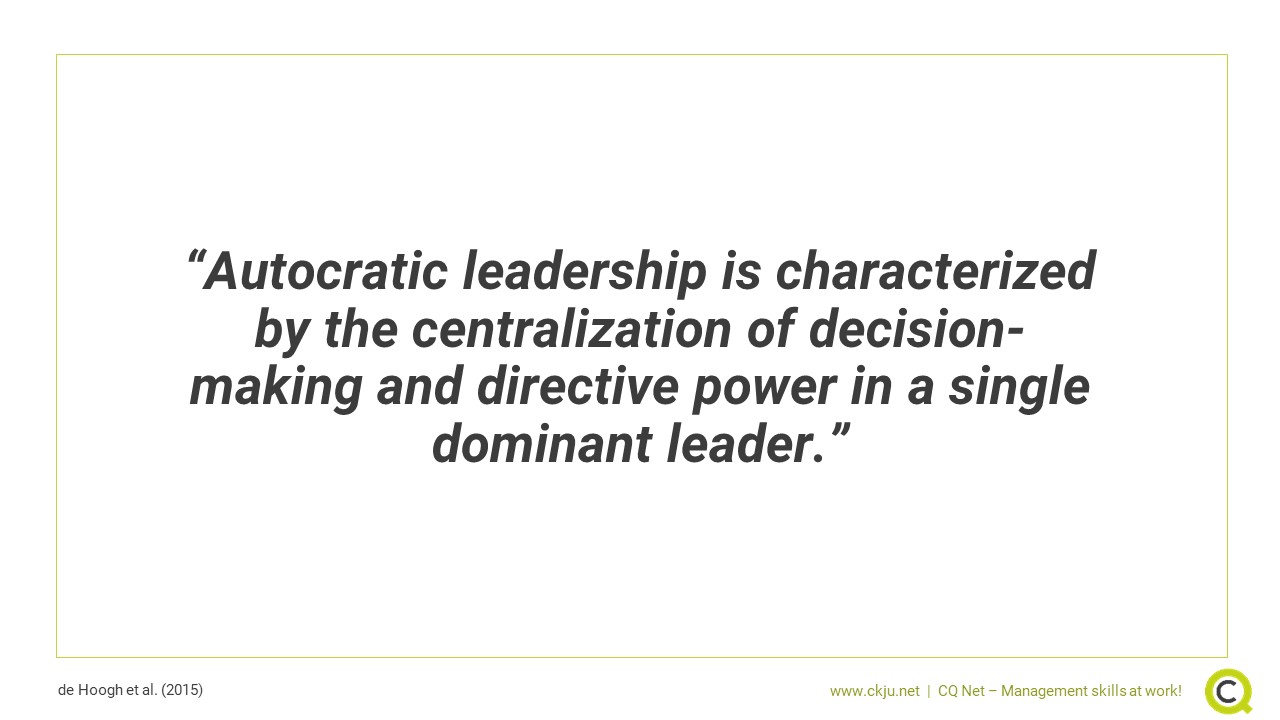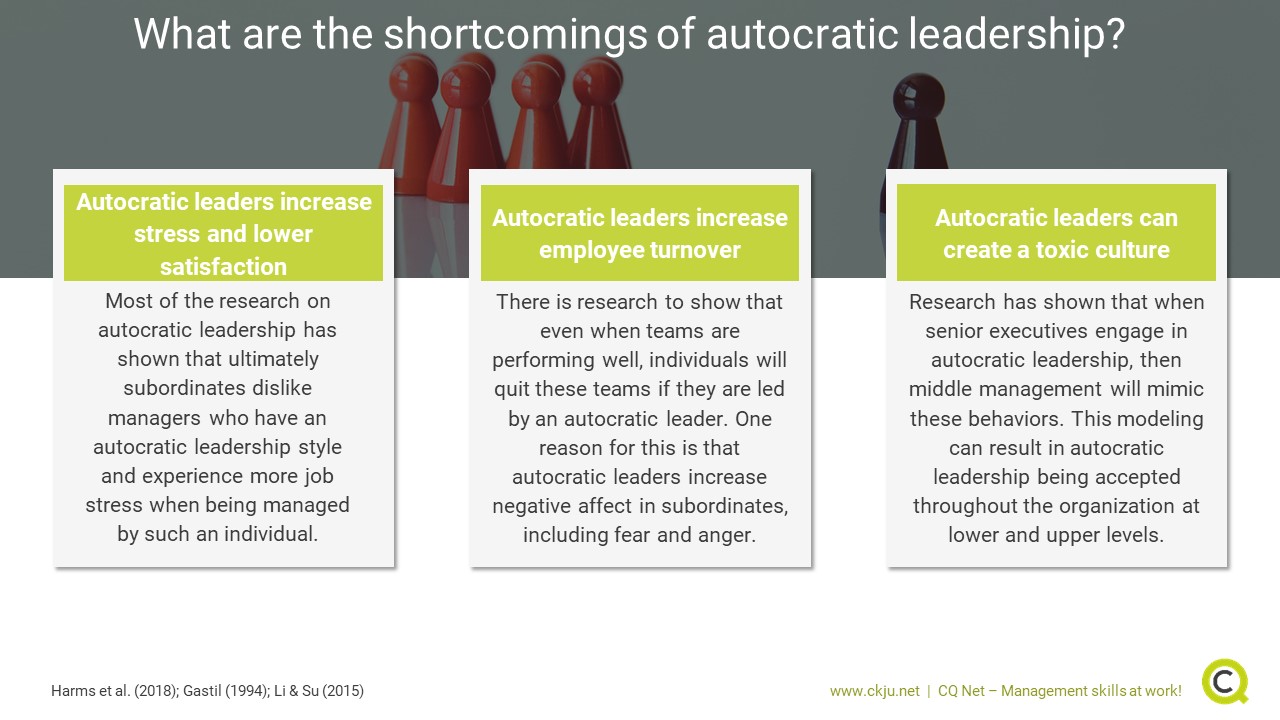- All Management Learning Resources
- Autocratic leadership

Why should you care about autocratic leadership?
In today’s global economy, organizations seek leaders who bring out the best in their subordinates. Professionals can display a range of leadership behaviors including autocratic leadership, whereby management control organizational practices and procedures. As a professional, it is important to be aware of the positives and negatives of autocratic leadership because it can have an impact on individual and team performance and morale (De Hoogh, Greer & Den Hartog, 2015).
Contents
- Why should you care about autocratic leadership?
- What is autocratic leadership?
- How does autocratic leadership work?
- How to measure autocratic leadership
- How to implement autocratic leadership
- What are the benefits of autocratic leadership?
- What are the shortcomings of autocratic leadership?
- Key recommendations for professionals
- References and further reading
What is autocratic leadership?
When a manager utilizes an autocratic leadership style, the manager drives decision-making. A recent definition of autocratic leadership is that it is “characterized by the centralization of decision-making and directive power in a single dominant leader.” (de Hoogh et al., 2015).
The use of autocratic leadership creates hierarchy between management and subordinates and also within teams whereby the leader plays a dominant role in driving practices and procedures.
Autocratic leadership is typically used when there is little room for error in performing tasks such as in jobs that are dangerous or require a high degree of safety.
How does autocratic leadership work?
Depending on the way it is implemented and the situation you face, autoratic leadership can have a positive or negative impact on a set of team and organizational outcomes.
Autocratic leadership impacts team performance
Autocratic leadership can have both beneficial and negative outcomes on team performance. It is important for professionals to consider when it is appropriate to use this style of leadership. When team members accept the hierarchy imposed by autocratic leadership, autocratic leadership can increase team performance through increasing team psychological safety (de Hoogh et al., 2015). However, when the hierarchy is challenged by team members, then autocratic leadership has a negative impact on team performance (de Hoogh et al., 2015).
Autocratic leadership impacts subordinate work stress
When professionals are pressed for time, they will adopt a more autocratic approach with their subordinates. This can lead to subordinates experiencing work stress and lower well-being (Briker, Walter & Cole, 2020). It is important for professionals to identify when they are pushed for time, because this can result in engaging in autocratic leadership behaviors that aren’t conducive to team effectiveness.
Subordinates who lack confidence are attracted to autocratic leaders
When employees are unsure about their abilities, they are more likely to be attracted to autocratic leaders (Rast, Hogg & Giessner, 2013). When employees are confident about their role in the organization and have a high sense of identity, they are more supportive of a non-autocratic leader (Rast et al., 2013). Within group functioning, employees who lack self-certainty, appear to expect this type of autocratic behavior from their group leader (Rast et al., 2013).
How to measure autocratic leadership
There is a 5-item measure of autocratic leadership behavior that employees complete to rate their manager’s level of autocracy (De Hoogh et al., 2004). Previously developed for use in Holland, the measure has also been used in the United States and has shown strong interrater agreement, intraclass correlations, and acceptable reliability indices (alpha = .74) (Briker et al., 2020). Items include the following examples:
- “my supervisor is bossy, and orders subordinates around”, and
- “my supervisor is very critical of new ideas.”
How to implement autocratic leadership
Managers should be judicial when choosing to engage in autocratic leadership behaviors because it has the potential to decrease employees’ well-being. However, there are times when an autocratic leadership style becomes an option – in times of uncertainty and when employees are unsure of themselves (Schoel, Bluemke, Mueller & Stahlberg, 2011).
Fiedler’s contingency theory suggests that individual and team success is not always a function of a particular leadership style such as transformational leadership or shared leadership. it also depends on the situation (Schoel et al., 2011). Most employees view autocratic leaders as distasteful and prefer a democratic leader who asks followers for ideas (Schoel et al., 2011).
However, previous research shows that although teams who have a democratic leader display a high level of morale and satisfaction, they are not necessarily more productive. An autocratic manager who is unpopular might lead a highly productive team because of their direct style (Schoel et al., 2011).
Subordinates’ individual differences play a role in determining the effectiveness of autocratic leadership. Schoel and colleagues found that when there was uncertainty about roles, employees who had low self-esteem preferred an autocratic leader and were more successful whereas those with high self-esteem preferred a democratic leader and this contingency also led to success.
What are the benefits of autocratic leadership?
As with every leadership approach, autocratic leadership does have a set of benefits and shortcomings as well. The benefits are mostly related to speed in decision-making, time pressure, a high level of ambivalence and low complexity.
Autocratic leadership leads to quick decision-making
Because autocratic leaders are driven by time urgency, they are more likely to make quick decisions and this can lessen the impact of procrastination (Briker et al., 2020). Moreover, because autocratic leaders do not seek ideas from their followers, they make solo decisions leading to faster outcomes.
Newcomers benefit from autocratic leaders
When new employees start a new job, they are often unsure of their role and need direction. This is particularly true if it is an employee’s first job such as a recent college graduate. In these types of uncertain situations and if the employee is struggling with low self-esteem, an autocratic leader can be effective through giving direction (Schoel et al., 2011)
During stressful periods, autocratic leaders can be effective
When efficiency is needed and there is little time for meaningful organizational and workplace communication, autocratic leadership can be effective (Harms, Wood, Landay, Lester & Vogelgesang, 2018). Research has shown that during harsh economic times, such as the current crisis due to the Pandemic, autocratic leadership is more effective than transformational leaders for firm effectiveness (Huang et al., 2015).
What are the shortcomings of autocratic leadership?
Depending on the way it is implemented, autocratic leadership is associated with a set of negative consequences for individuals, teams, and the entire organizations. In addition, there is a risk that autocratic leadership fosters a toxic and destructive organizational environment that could do more harm than good.
Autocratic leaders increase stress and lower satisfaction
Most of the research on autocratic leadership has shown that ultimately subordinates dislike managers who have an autocratic leadership style and experience more job stress when being managed by such an individual (Harms et al., 2018). In a meta-analytic review, Gastil (1994) found that autocratic leadership was associated with lower levels of satisfaction, although autocratic leadership was not linked to group productivity.
Autocratic leaders increase employee turnover
There is research to show that even when teams are performing well, individuals will quit these teams if they are led by an autocratic leader. One reason for this is that autocratic leaders increase negative affect in subordinates, including fear and anger (Harms et al., 2018). Moreover, because autocratic leaders are less likely to value creative ideas from subordinates, employees might feel less valued and this has the potential to increase employee turnover.
Autocratic leaders can create a toxic culture
Research has shown that when senior executives engage in autocratic leadership, then middle management will mimic these behaviors (Li & Sun, 2015). This modeling can result in autocratic leadership being accepted throughout the organization at lower and upper levels. This increase in hierarchy can lead to an ineffective culture, undermine innovation and it also makes it difficult for organizations to change from an autocratic culture to a more democratic environment.
Key recommendations for professionals
- Autocratic leadership works when team members accept hierarchy within the organization
- Autocratic leadership is ineffective when management is pushed for time
- Autocratic leadership is effective when employees lack confidence
- Autocratic leadership is distasteful to most employees yet can be effective when a direct style is required
- During stressful periods, autocratic leaders can be effective
References and further reading
Briker, R., Walter, F., & Cole, M,S. (2020). Hurry up! The role of supervisors’ time urgency and self‐perceived status for autocratic leadership and subordinates’ well‐being. Personnel Psychology. Article retrieved from: https://onlinelibrary.wiley.com/doi/full/10.1111/peps.12400
De Hoogh, A., Greer, L., & Den Hartog. D (2015). Diabolical dictators or capable commanders? An investigation of the differential effects of autocratic leadership on team performance, The Leadership Quarterly, 26, Issue 5,687-701,
Gastil, J. (1994). A Meta-Analytic Review of the Productivity and Satisfaction of Democratic and Autocratic Leadership. Small Group Research, 25, 3, 384–410.
Harms, P.D, Wood, D., Landay, Karen, Lester, Paul B, & Vogelgesang Lester, Gretchen. (2018). Autocratic leaders and authoritarian followers revisited: A review and agenda for the future. The Leadership Quarterly, 29, 1), 105–122.
Huang, H., Xu, E., Chiu, W., Lam, C., & Farh, J. (2015). When authoritarian leaders outperform transformational leaders: firm performance in a harsh economic environment. Academy of Management Directives, 1, 180-200.
Li, Y & Sun, J. (2015). Traditional Chinese leadership and employee voice behavior: A cross-level examination, The Leadership Quarterly, 26, 2, 172-189,
Rast, D. E, Hogg, M., & Giessner, S. R. (2013). Self-uncertainty and Support for Autocratic Leadership. Self and Identity, 12,6, 635–649.
Schoel, C., Bluemke, M., Mueller, P., & Stahlberg, D. (2011). When Autocratic Leaders Become an Option-Uncertainty and Self-Esteem Predict Implicit Leadership Preferences. Journal of Personality and Social Psychology, 101, 3, 521–540.
About the Author





